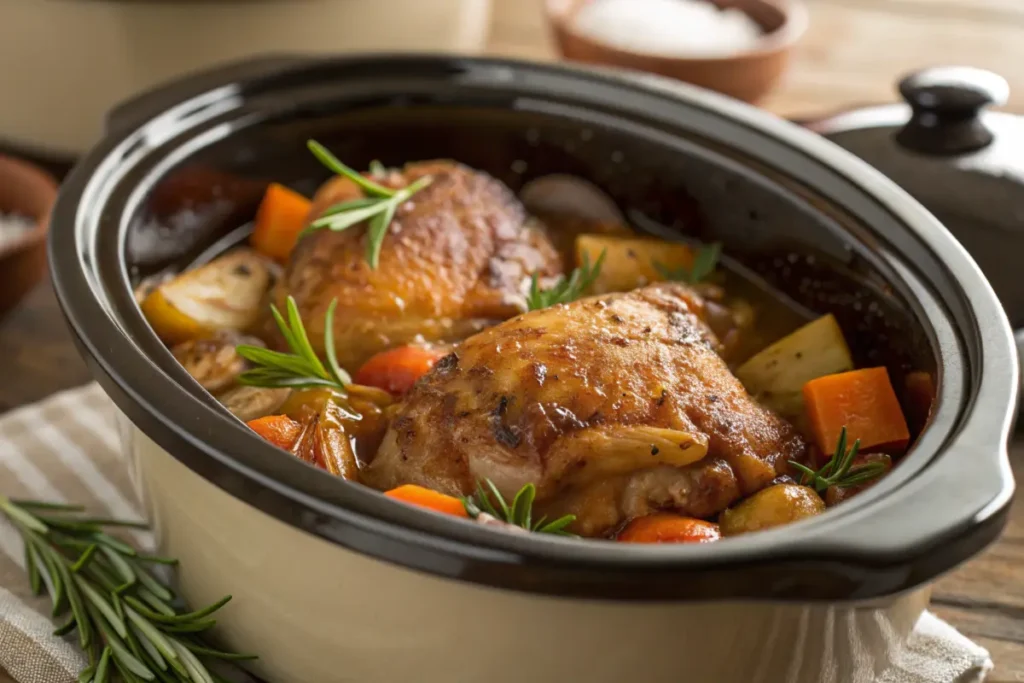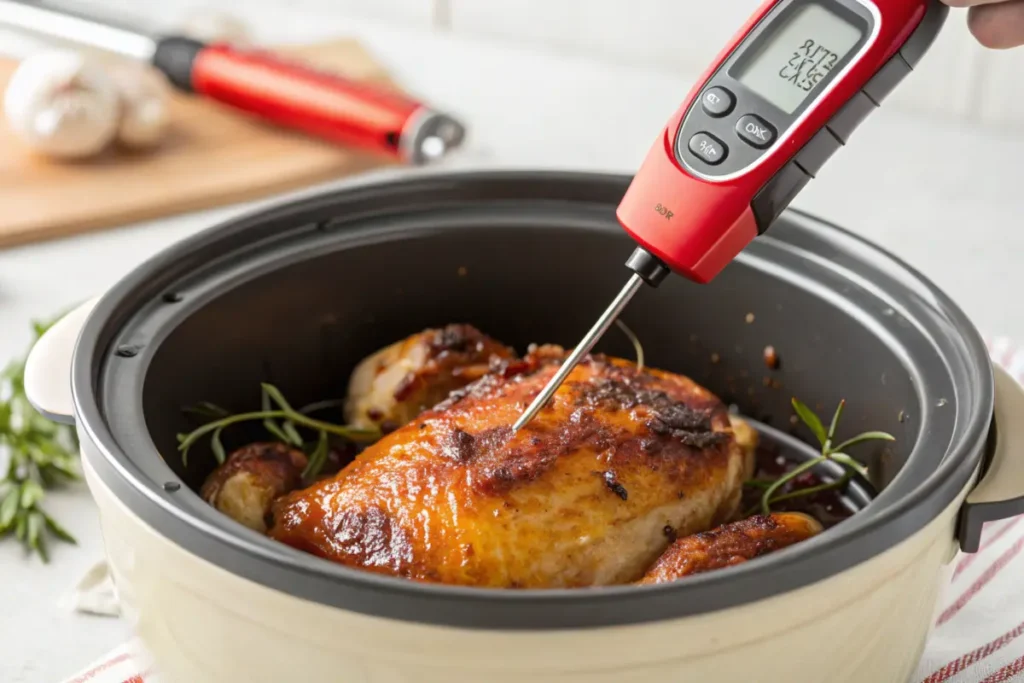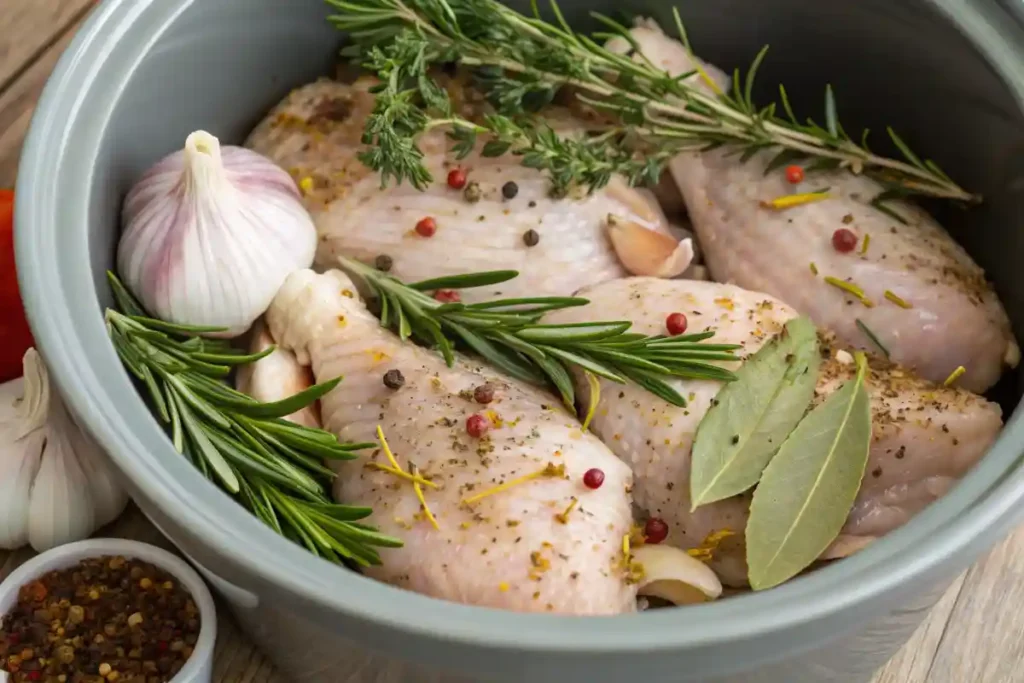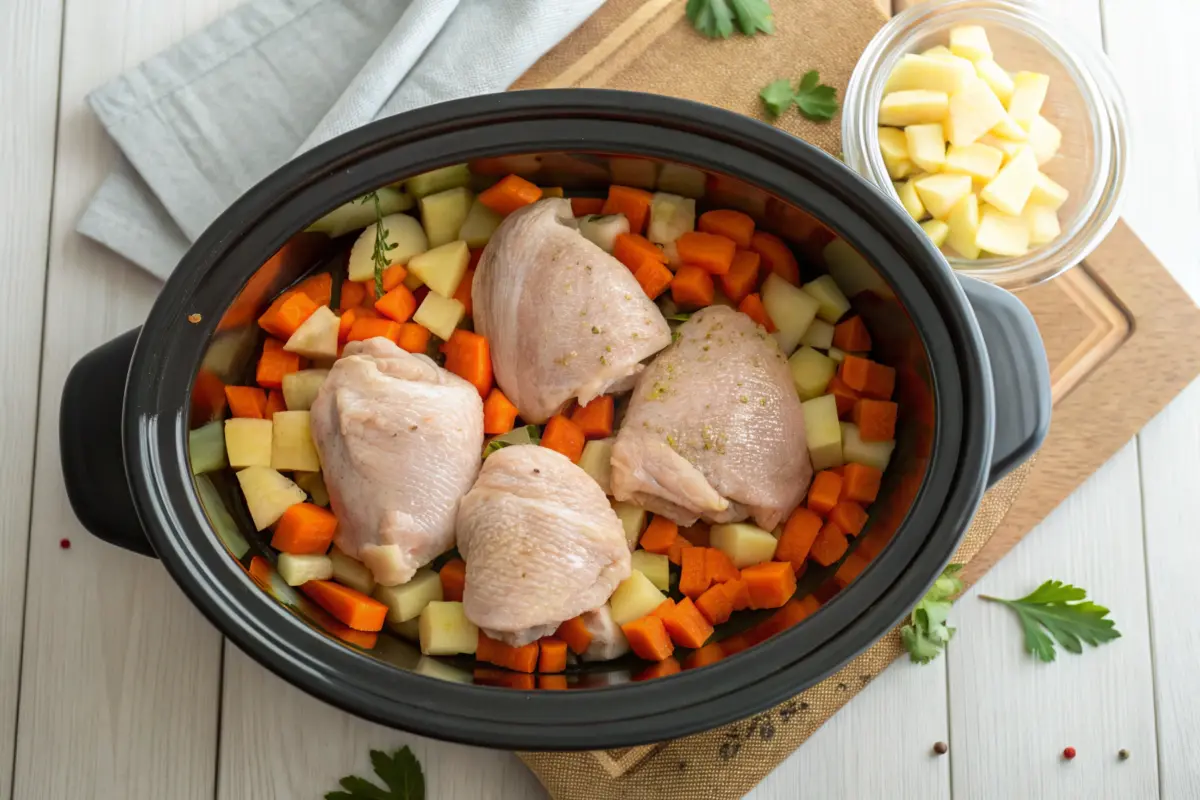Introduction
Cooking chicken in a crock pot is an incredibly convenient way to prepare hearty meals. But here’s the million-dollar question: “Is it okay to put raw chicken in a crock pot?” While it may seem straightforward, there’s plenty to consider, from food safety to proper preparation and optimal cooking techniques. In this article, we’ll unravel the mysteries of slow cooking raw chicken, dive into expert tips, and explore the best practices to ensure your meals turn out both safe and delicious. Let’s dig in!
Understanding Crock Pot Cooking
How a Crock Pot Works

A crock pot operates on a simple principle: low, consistent heat over an extended period creates tender and flavorful dishes. This magical appliance uses a ceramic or metal pot, surrounded by heating elements, to gently cook food.
Unlike traditional stovetop or oven methods, a crock pot locks in moisture by trapping steam beneath its lid. The heat rises slowly from the base, distributing evenly throughout the dish. This process not only tenderizes tougher cuts of meat but also allows flavors to blend beautifully.
One of the standout features of crock pot cooking is its “set it and forget it” approach. You can prep your ingredients, pop them in, and let the magic happen while you go about your day. But here’s the kicker: the placement of your ingredients in the pot plays a massive role in how well everything cooks.
Importance of Ingredient Placement in Slow Cooking
The arrangement of ingredients in a crock pot isn’t just about aesthetics—it’s science. Denser vegetables like potatoes, carrots, and parsnips take longer to cook, so they should go on the bottom, closest to the heat source. This ensures they’ll soften to perfection.
Proteins like chicken, on the other hand, often go on top of the vegetables. Why? As the chicken cooks, its juices flow downward, soaking into the vegetables and adding layers of flavor. This layering not only improves taste but also prevents ingredients from overcooking or drying out.
When layering for a dish like chicken stew, for instance, you’d place hearty vegetables at the bottom, chicken pieces in the middle, and delicate items like herbs or quick-cooking veggies (e.g., peas or tomatoes) on top. This strategic stacking helps achieve even cooking and ensures no ingredient is underdone or overdone.
Crock pots are fantastic tools for busy home cooks, but understanding how they work and why placement matters can make all the difference in your culinary adventures. Now that we’ve laid the groundwork, let’s move on to the critical topic of food safety when cooking chicken.
Understanding Crock Pot Cooking
How a Crock Pot Works
A crock pot, or slow cooker, is a kitchen powerhouse that simplifies meal preparation by cooking food slowly and steadily at low temperatures, typically between 170°F and 280°F. This gradual cooking process breaks down tough fibers in meats, making them tender and juicy, while allowing the flavors of all the ingredients to meld together beautifully.
The crock pot’s design ensures even heat distribution. Heat rises from the base and surrounds the pot, creating a consistent environment for cooking. The tight-fitting lid plays a crucial role, trapping steam and moisture inside, which keeps your food from drying out and intensifies the flavors.
Whether you’re whipping up a hearty chicken stew or a simple vegetable medley, the crock pot’s low-and-slow approach delivers reliable results. However, how you layer the ingredients inside can significantly influence the final outcome, and that’s where strategy comes into play.
Importance of Ingredient Placement in Slow Cooking
The order in which you layer ingredients in a crock pot is more important than you might think. Dense vegetables such as potatoes, carrots, and parsnips take longer to cook than softer items like chicken or zucchini. For this reason, they belong at the bottom of the pot, where they’re closest to the heat source. This ensures they cook through evenly and don’t remain underdone.
Proteins, like chicken, typically go on top of the vegetables. Why? As the chicken cooks, it releases juices that flow downward, infusing the vegetables with flavor. Additionally, this placement prevents the chicken from overcooking too quickly, as the vegetables act as a cushion, shielding it from direct heat.
When using delicate ingredients such as herbs, tomatoes, or quick-cooking greens, it’s best to place them on top or add them during the last hour of cooking. This prevents them from wilting or losing their flavor too early.
Ingredient placement in a crock pot isn’t just about ensuring things cook properly—it’s also about optimizing flavor. By understanding how your slow cooker distributes heat and layering ingredients strategically, you’ll consistently achieve tender, flavorful meals. Next, we’ll explore the vital topic of food safety when slow-cooking chicken.
Food Safety Guidelines for Cooking Chicken

Safe Internal Temperature
When cooking chicken, especially in a crock pot, reaching the correct internal temperature is non-negotiable. Chicken must achieve an internal temperature of at least 165°F (74°C) to ensure harmful bacteria like Salmonella and Campylobacter are destroyed. These bacteria are naturally present in raw poultry and can cause serious health issues if not eliminated during cooking.
Using a meat thermometer is the most reliable way to confirm doneness. Insert the thermometer into the thickest part of the chicken, avoiding bones, as they can give inaccurate readings. This simple step guarantees your chicken is fully cooked and safe to eat.
Slow cookers are designed to bring foods up to safe temperatures steadily, so you don’t need to worry about the extended cooking time as long as you set the right temperature and cooking duration.
Risks of Undercooked Chicken
Undercooked chicken is a recipe for disaster—literally. Consuming chicken that hasn’t been cooked to the proper temperature can lead to foodborne illnesses, with symptoms including nausea, vomiting, diarrhea, abdominal cramps, and even fever. These symptoms are often caused by bacteria that survive inadequate cooking.
In a crock pot, there’s a common concern that low temperatures might not kill bacteria. However, as long as the chicken reaches the safe temperature of 165°F, these risks are eliminated. That’s why monitoring the cooking process and checking the temperature are essential steps.
Moreover, never guess if your chicken is done based on appearance. Chicken can look cooked on the outside while remaining undercooked inside. Trust your thermometer, not your eyes. Thorough cooking is your best line of defense against foodborne illnesses.
By following these guidelines, you can confidently prepare chicken in your crock pot, knowing it’s both safe and delicious. Now, let’s look at whether it’s safe to place raw chicken directly into the slow cooker in the next section.
Is It Safe to Put Raw Chicken in a Crock Pot?
USDA Guidelines
The USDA confirms that cooking raw chicken in a crock pot is entirely safe, provided it is done correctly. Crock pots are designed to slowly raise the temperature of food to a level that kills bacteria such as Salmonella and Campylobacter. As long as the chicken reaches an internal temperature of 165°F (74°C), it is safe to eat.
The slow cooking process ensures that heat is distributed evenly, and the lid traps steam to help maintain a consistent temperature. Whether you’re using a high or low setting, the crock pot method can safely cook raw chicken to perfection, eliminating harmful bacteria.
Common Concerns and Misconceptions
One of the most common misconceptions about crock pots is that their low temperatures aren’t sufficient to make raw chicken safe. However, this concern is unwarranted if you follow proper practices. Crock pots are engineered to cook food thoroughly over time, bringing all ingredients, including raw chicken, to safe levels.
A key to addressing these concerns is monitoring the internal temperature. Using a meat thermometer ensures the chicken reaches 165°F, no matter how long it’s been cooking. Additionally, starting with fresh or properly thawed chicken helps maintain safety throughout the cooking process.
These guidelines debunk the myths surrounding crock pot safety and prove that it’s a reliable way to cook raw chicken as long as precautions are followed. Next, let’s look at how to prepare raw chicken for slow cooking to get the best results.
Proper Preparation of Raw Chicken for Slow Cooking
Thawing Chicken Safely
Before cooking raw chicken in a crock pot, it’s essential to thaw it properly. Frozen chicken should always be thawed in the refrigerator, as this keeps it at a safe temperature during the process. Alternatively, you can use a microwave’s defrost setting if you need to thaw quickly.
Avoid thawing chicken at room temperature, as this creates an environment where bacteria can multiply rapidly. Starting with fully thawed chicken ensures even cooking and eliminates cold spots that might harbor harmful bacteria.
Marinating and Seasoning
Marinating is a great way to add flavor to your crock pot chicken dishes, but it must be done safely. Always marinate chicken in the refrigerator to keep it at a safe temperature. Once the marinating is complete, discard any leftover marinade that came into contact with the raw chicken. Using this marinade for basting or sauce without cooking it first can lead to cross-contamination.
To boost flavor, season chicken generously before placing it in the crock pot. Using fresh herbs, spices, and aromatics like garlic or onions enhances the dish, ensuring every bite is infused with rich taste.
Avoiding Cross-Contamination
Handling raw chicken requires strict hygiene practices to prevent cross-contamination. Use separate cutting boards, knives, and utensils for chicken, and avoid letting it come into contact with other foods.
After preparing the chicken, wash your hands, utensils, and surfaces thoroughly with hot, soapy water. Cleaning up immediately reduces the risk of bacteria spreading to other areas of your kitchen. By taking these precautions, you’ll create a safe and clean environment for preparing raw chicken in your crock pot.
Armed with these preparation tips, you’re ready to move forward with confidence. Up next, we’ll dive into cooking times and temperatures to perfect your slow-cooked chicken dishes.
Enhancing Flavor in Crock Pot Chicken Dishes

Seasoning Techniques
To elevate the taste of crock pot chicken dishes, don’t shy away from bold seasonings. Generously coat the chicken with a blend of herbs, spices, and aromatics before cooking. Common favorites include garlic, onion, paprika, thyme, and rosemary. These ingredients enhance the natural flavors of the chicken and create a more robust dish.
For an extra layer of flavor, consider rubbing spices directly onto the chicken before placing it in the pot. If time allows, marinating the chicken overnight can further infuse it with seasoning. Adding aromatics such as bay leaves or cloves during cooking also helps to create a fragrant, flavorful broth.
Using Broths and Sauces
Liquids are essential in a crock pot to keep chicken moist and tender. Adding broth, sauces, or even coconut milk can impart additional flavors to the dish. Chicken or vegetable broth is an excellent base for savory recipes, while tomato-based sauces work well for heartier meals.
To prevent the chicken from drying out, ensure there’s enough liquid in the pot to cover the vegetables and partially submerge the chicken. For a thicker sauce, add ingredients like crushed tomatoes, cream, or a slurry of cornstarch and water toward the end of the cooking time. The slow simmering process will meld these flavors into a rich, cohesive dish.
Common Mistakes to Avoid
Overfilling the Crock Pot
It’s tempting to pack the crock pot to the brim, but overfilling is a surefire way to ruin a dish. When the pot is too full, heat circulation is hindered, leading to uneven cooking. The chicken may end up undercooked in the center, while the edges are overdone.
For the best results, stick to the recommended fill levels—no more than two-thirds full. This ensures proper heat distribution, allowing all ingredients to cook evenly.
Lifting the Lid During Cooking
Resist the urge to peek! Lifting the lid during cooking releases steam and heat, disrupting the consistent temperature required for even cooking. Each time you remove the lid, you can add up to 20-30 minutes to the overall cooking time.
Instead, trust the process. Use a clear lid, if available, to monitor the progress without releasing heat. If you need to check the chicken’s temperature, wait until it’s nearing the end of the recommended cooking time to avoid unnecessary interruptions.
By following these flavor-boosting tips and avoiding common mistakes, your crock pot chicken dishes will turn out perfectly seasoned and thoroughly cooked every time. Up next, we’ll discuss how to keep your crock pot clean and well-maintained for future culinary adventures.
Cleaning and Maintenance of Your Crock Pot
Proper Cleaning Techniques
After a delicious meal, cleaning your crock pot properly is essential to maintain hygiene and extend its lifespan. Start by allowing the crock pot to cool completely—pouring cold water into a hot pot can cause cracking. Once cooled, remove the stoneware insert and lid, and wash them with warm, soapy water.
For stubborn food residues, soak the stoneware in warm water for 15–20 minutes before scrubbing with a non-abrasive sponge. Avoid using harsh cleaning tools, as they may damage the surface. Rinse thoroughly and let it air dry or dry with a clean towel.
The outer casing of the crock pot, which houses the heating element, should never be submerged in water. Instead, wipe it clean with a damp cloth to remove any spills or grease.
Maintaining the Appliance
Routine maintenance of your crock pot ensures it stays in excellent working condition. Inspect the stoneware for chips or cracks before each use, as damaged inserts can lead to uneven cooking or spills. If you notice any wear and tear on the electrical cord or heating element, discontinue use until repairs are made or the appliance is replaced.
Store your crock pot in a cool, dry place to protect it from moisture and dust. Following these maintenance practices will keep your crock pot safe and reliable for years to come.
Frequently Asked Questions
Can you put raw chicken and vegetables together in a crock pot?
Yes, it’s perfectly safe to place raw chicken and vegetables together in a crock pot. The key is ensuring the chicken reaches an internal temperature of 165°F to eliminate any harmful bacteria.
Do you need to brown chicken before slow cooking?
Browning chicken before slow cooking is optional. While it’s not required for safety, browning adds flavor and improves the chicken’s appearance by creating a caramelized crust. It’s an extra step that can elevate your dish, but skipping it won’t compromise the final result.
How long does it take to cook raw chicken in a crock pot?
Cooking times for raw chicken in a crock pot typically range from 6-8 hours on low to 3-4 hours on high. The exact time depends on the cut and size of the chicken. Always use a meat thermometer to confirm the internal temperature has reached 165°F.
Is it safe to cook frozen chicken in a crock pot?
While some recipes suggest cooking frozen chicken in a crock pot, it’s generally recommended to thaw chicken beforehand. Thawing ensures the chicken cooks evenly and reaches a safe temperature throughout the cooking process, reducing the risk of bacterial growth.
With proper cleaning, maintenance, and adherence to safety guidelines, your crock pot will continue to produce flavorful, safe, and satisfying meals.

